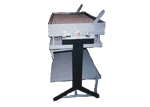 |
|
 |
 |
Chalk Making MachineThe high efficiency chalk making machine made in our factory is a modern design synthesizing all advantages of chalk machines both in China and abroad. It is reasonable in structure and convenient for operation. It produces 1,000 pieces of chalk at one machine cycle. Structure and characteristics. The chalk making machine consists of four main parts, namely the chalk moulding box, the chalk stripping system, the frame of the ejecting mechanism and dumper • Made of the seamless red copper tubes, the mould has high smooth, rustproof inner surface, which will have a very long servicing life. • Equip with hand bar, roller bearings, the ejecting mechanism can smoothly and nimbly operated. • For preventing the liquid chalk material and dust gong into the operating mechanism of the machine, the frame of the ejecting mechanism is wholely sealed. • The dumper is equip with center adjusted roller bearings, so it can be effortlessly and easily turned over. Installation and starting upBefore starting, the machine should be steadily placed on a hard surface. The mechanism should be seriously checked if there is any loose. At the meantime, clean the whole machine thoroughly and lubricate all the lubricating points. Operate with no load several times. The machine can be put into operation only in the condition that every part of it is in good order. Operation• Take the mould box to the injecting position. • Apply few lubricating liquids (oil) on the mould. • Put the milky chalk material into the trough. Take out the surplus material before solidifying. After the material fully solidified, operate the hand bar by hand and turn the mould box to 180 O , the chalk will draw down to the table from the moulds automatically; if there were also have some chalk stay in the moulds, please turn the three united bars located on the bottom of the box ( you can see it when you turn the box for 180 O ) for a cycle, the spare chalks will draw down. Those are the chalks you wanted. Turn the box to the first position for the next injection.For the information of the material--- gypsum, please view material page. |
|
 |
||
 |
||
|
|
Melt the solid into liquid, then supply it to the candle making machine or the paraffin powder spraying machine. |
The equipment to make the T-light shape candle, votive shape cadle, pillar shape candle by express, automatic one. Needs the paraffin powder as the raw material. |
The equipment to make chalk or crayon.
|
|
||||||||||||||
|
|
|
members only |
|
|
||||||||||||||
![]()
|









